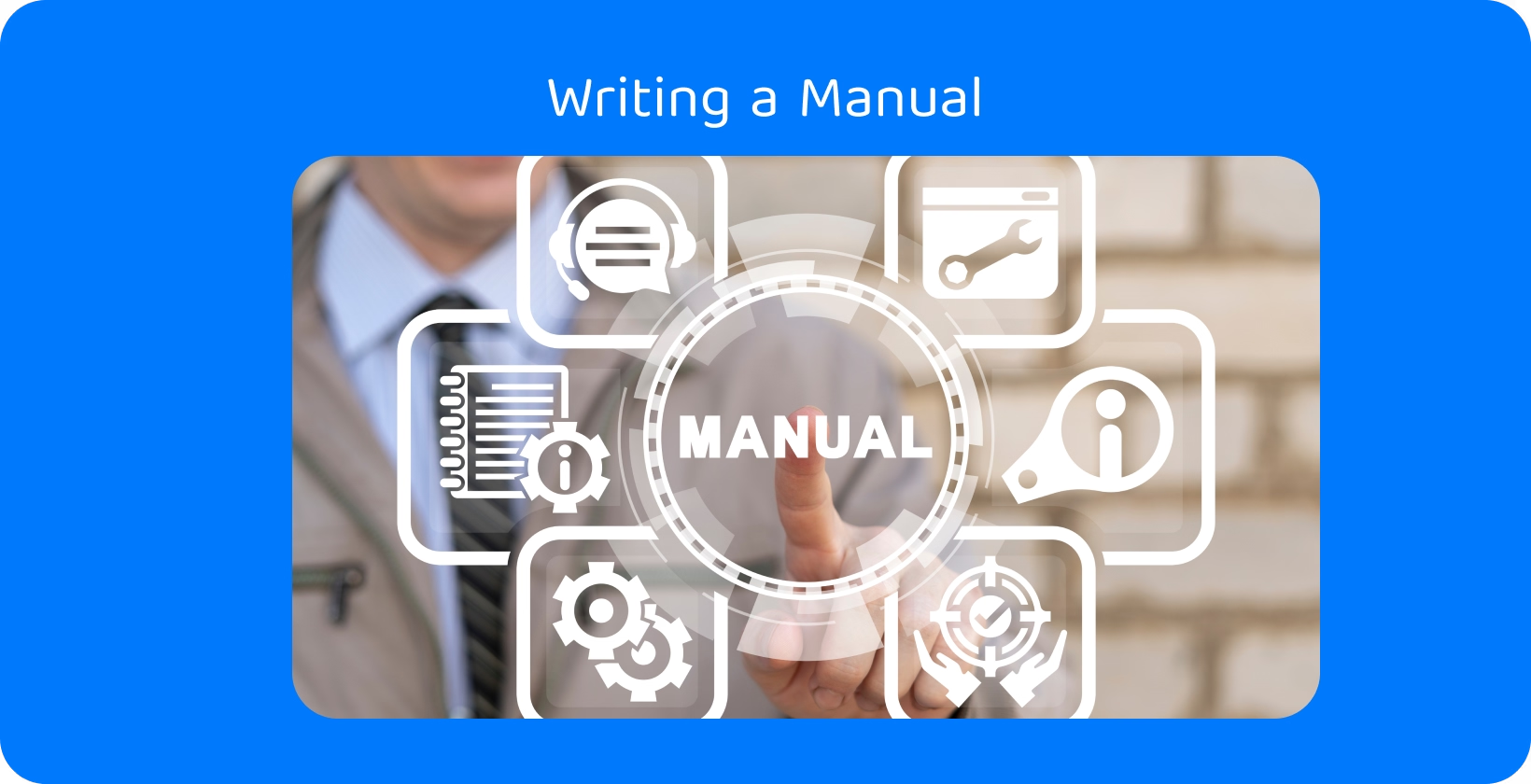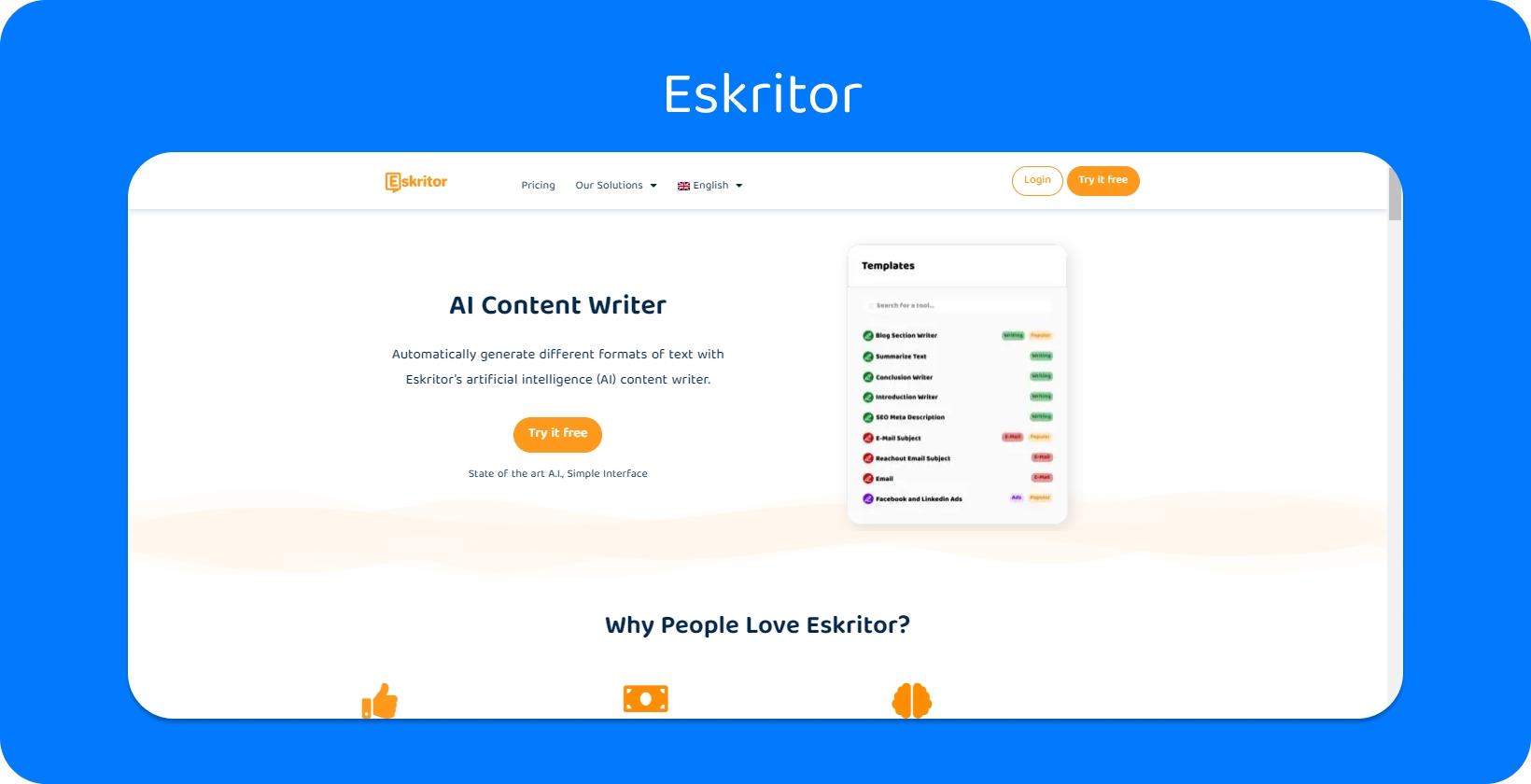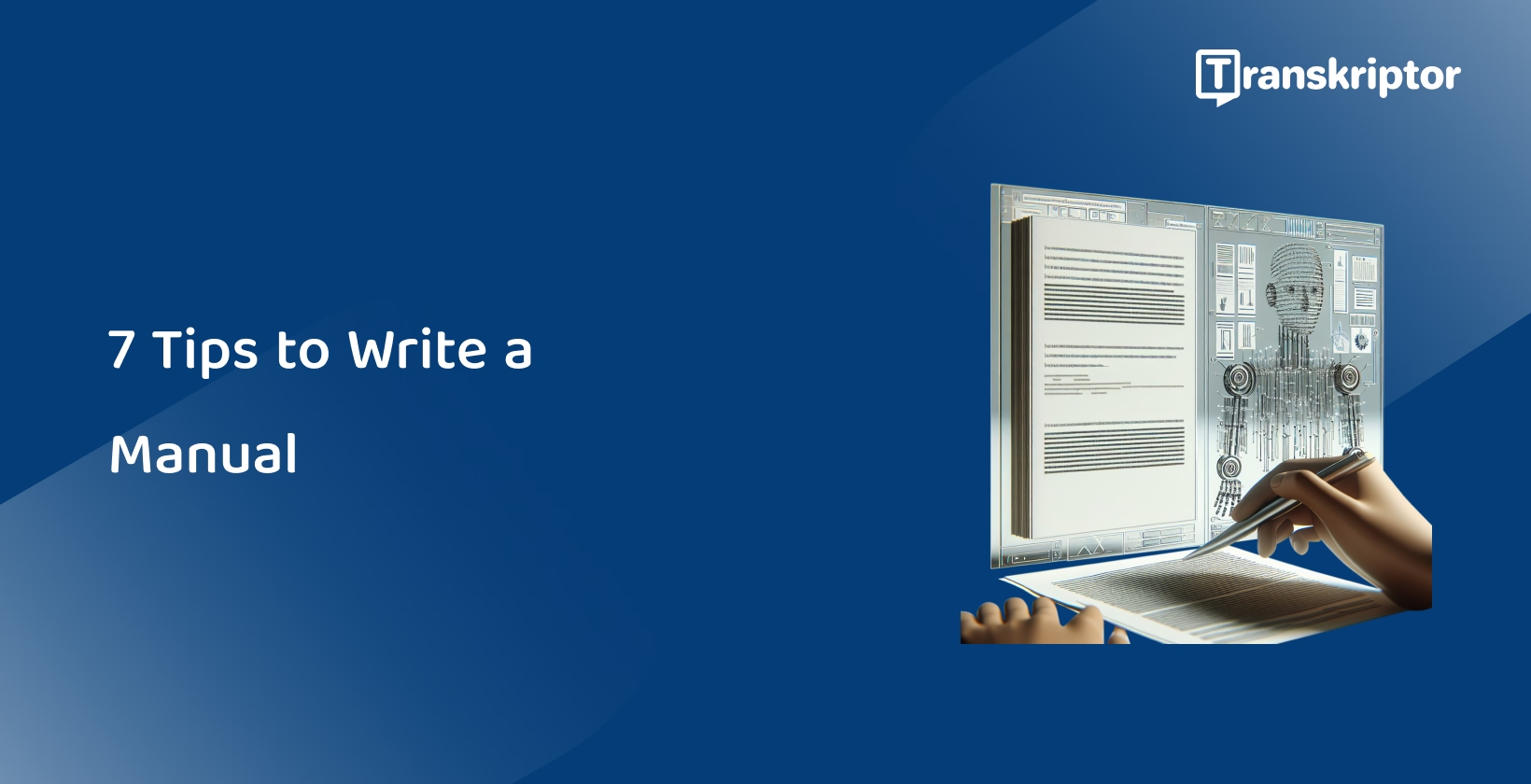Eskritor tackles the main challenge of creating an accessible, user-friendly manual by emphasizing clear, concise instructions tailored to enhance user comprehension and application based on summarized knowledge.
Tips on how to write a manual are listed below.
- Outline clear objectives: Outline clear objectives for each section to ensure users grasp the manual's goals.
- Use simple language: Ensure that all users, regardless of their technical background, should comprehend the manual.
- Organize information logically: Organize information by grouping related topics together when you write a guideline.
- Include visual aids: Enhance user comprehension and retention by including visual aids.
- Provide step-by-step instructions: Break down processes into step-by-step instructions when you write a tutorial to allow users to follow along.
- Test instructions for clarity: Test the instructions with actual users to ensure they are led to the desired outcome.
- Offer troubleshooting tips: Anticipate potential user errors or questions by offering troubleshooting tips.

1. Outline clear objectives
Outlining clear objectives is paramount when users write a manual. Objectives serve as guiding lights, directing users to utilize the manual's content successfully.
Objectives should be specific and measurable, ensuring users know exactly what they should accomplish after reading the manual. They also must align with users' needs and expectations.
Goals should be realistic and achievable within the manual's scope. They should also be clearly communicated within the manual, preferably at the beginning, to provide users with a roadmap of what to expect and gain from it.
Outlining clear objectives empowers users to engage with the manual confidently, knowing precisely what they aim to accomplish and how the manual will help them achieve their goals.
2. Use simple language
The language chosen for a manual directly impacts its accessibility and utility for the user. It is imperative to employ simple, clear language that speaks directly to the user when technical copywriters write a user guide, regardless of their prior knowledge or experience with the product or process. This approach removes barriers to comprehension, allowing users to grasp instructions and apply them effortlessly.
Complex jargon and technical terms, unless absolutely necessary, are replaced with everyday language to ensure that the content is approachable. Users also appreciate when information is presented concisely, with each sentence contributing to their understanding of the subject matter. This means avoiding unnecessary details that detract from the main instructions or key points.
The use of straightforward language accelerates the learning process. It enhances the user's ability to retain information, making the manual a reliable and efficient tool for mastering new skills or products.
3. Organize information logically
Information organization within a manual is foundational to its effectiveness. It serves as the structural framework that guides the user through the learning process. The information must be presented logically and coherently when technical copywriters write a user guide, mirroring the user’s progression from initial acquaintance to proficiency.
This logical arrangement aids users in intuitively navigating the content, allowing them to build upon previously acquired knowledge without the need to backtrack or leapfrog through sections.
The manual's coherence significantly reduces the user's cognitive load, making the learning process more manageable and less daunting. Technical copywriters, while they write a tutorial, create a roadmap that users will confidently follow, knowing that each step builds logically on the last by thoughtfully organizing the information.
Streamline your manual's structure for accessibility with Eskritor. Try it free now and discover how Eskritor improves your documentation process.
4. Include visual aids
Incorporating visual aids into a manual significantly enriches the user's learning experience by providing clarity and context that text alone cannot achieve.
Visual elements such as images, diagrams, and charts act as anchor points that users refer to, bridging the gap between abstract instructions and their practical application. Technical copywriters should write instructions that illustrate complex processes, break down steps into parts, and highlight important information, making it recognizable.
Visual aids facilitate a deeper understanding of the material, catering to those who learn best through visual stimuli. Visuals also offer a reprieve from dense blocks of text, making the manual more approachable and less intimidating for users.
The strategic use of visual aids enhances comprehension and significantly boosts the user's engagement with the material, transforming the manual into a more interactive and effective learning tool.
5. Provide step-by-step instructions
Providing step-by-step instructions is essential for a manual that aims to guide users through tasks or the use of products with clarity and precision. This approach breaks down procedures into individual, manageable actions, making complex processes seem less daunting and more achievable.
Each step should be crafted to convey a single action when copywriters write instructions, ensuring that users will easily follow along without losing their place or becoming overwhelmed. The clarity of these instructions prevents misunderstandings and reduces the likelihood of errors, fostering a smoother learning experience.
Sequential guidance reassures users, offering them a clear pathway to follow and enhancing their confidence in executing tasks. This methodical breakdown allows users to pause and resume their learning at their own pace, accommodating different learning speeds and styles.
6. Test instructions for clarity
Testing instructions for clarity is essential when technical copywriters write a manual that genuinely serves its users.
It's important to have users from the intended audience try to follow the instructions as written before finalizing the manual. This process reveals whether the steps are clear, comprehensive, and easy to execute as described by technical copywriters who write a guideline.
Real-world applications by actual users will highlight areas that need simplification or further explanation. Feedback from these test runs should be taken seriously and used to refine the manual.
Users often encounter unforeseen issues or interpret instructions differently than expected, which will lead to valuable insights for improvement. Adjustments based on user experiences and testimonials from clients ensure that the final manual is more effective and user-friendly. The aim is to write a user guide that leads users to success without confusion or frustration.
A manual tested for clarity helps users and reduces the need for additional support and clarifications, making the product more accessible to everyone.
7. Offer troubleshooting tips
Including troubleshooting tips in a manual empowers users to resolve common issues independently. Identifying frequent problems users encounter and offering clear, concise solutions is essential. These tips become the first line of support, allowing them to quickly find and implement a solution without needing external help.
Troubleshooting sections should be easy to navigate, with problems clearly stated and followed by straightforward steps to resolve them. This enhances the user experience and instills confidence in users as they learn to solve problems independently. This approach minimizes frustration and downtime, improving overall satisfaction with the product.
Offering troubleshooting tips also reflects a deep understanding of the product and its use in real-life scenarios, further establishing trust between the user and the product.
What Is the Purpose of a Manual?
A manual guides users through a product or system's features, functions, and operations. It is an essential resource that provides all the necessary information for users to use and troubleshoot the product effectively. A well-crafted manual ensures that users have access to helpful and detailed instructions at any time, enhancing their understanding and ability to use the product to its full potential.
Manuals are crucial in reducing confusion and errors. They offer a clear pathway for users to follow, from basic setup to advanced features. They also significantly decrease customer service's need for direct support, allowing users to find solutions independently.
Manuals contribute to the safety of users by detailing proper usage practices and highlighting any potential hazards. They protect users and help avoid misuse by thoroughly explaining how to maximize the product's benefits while minimizing risks.
What Are the Challenges When Writing a Manual?
Writing a manual presents several challenges, including ensuring that the instructions are comprehensive yet easy to understand for all users.
Manuals must cater to a diverse audience with varying levels of expertise, making it necessary to address the needs of both novices and experienced users. This diversity often leads to the difficulty of avoiding technical jargon that should confuse newcomers while still providing the depth of information sought by more knowledgeable users.
Another challenge is structuring the manual in a way that users are able to easily navigate through sections relevant to their needs without getting lost in unnecessary details.
Manuals also need to anticipate the potential issues users will face and offer effective troubleshooting advice, which requires a deep understanding of the user's perspective and the product's intricacies.
Updates
Keeping a manual current with updates and changes presents a significant challenge. Manuals must be promptly revised as products evolve and new features are added. This ensures that users always have access to the latest information, which is vital for effective product use.
Regularly reviewing and updating the manual will be demanding, requiring a dedicated effort to track product design or functionality changes. It's important for the manual to incorporate new information and remove or adjust outdated content to prevent confusion among users.
This process involves thoroughly understanding the updates and how they impact the user experience. Communicating changes in a way that is easy for users to understand and apply is crucial.
Completeness
Ensuring completeness in a manual without overwhelming the reader is a challenging balance. Manuals must cover all necessary information to guarantee that users fully understand and operate the product efficiently.
This includes setup instructions, usage guidelines, troubleshooting tips, and safety warnings. Every feature and function must be explained, leaving no question unanswered, to provide a comprehensive resource. Presenting this information in a way that is not intimidating or excessively detailed is crucial.
The goal is to give users the knowledge they need without burdening them with too much information at once. Achieving this involves organizing the content logically so users easily navigate to the sections relevant to their needs.
Simplifying complex information into digestible, easy-to-follow instructions is key. Using clear and concise language helps prevent the manual from becoming too dense.
Accessibility
Ensuring accessibility for all users, including those with disabilities, is a critical yet challenging aspect of creating a manual.
Manuals must be designed to be easily understandable and usable by everyone, which means considering various needs. This involves providing text descriptions for images or ensuring that digital versions are compatible with screen readers for users with visual impairments.
Alternatives like audio instructions greatly enhance accessibility for those struggling with traditional printed or digital text. The manual also should be available in formats that support various assistive technologies, catering to users with mobility issues that are able to prevent them from easily navigating through a document.
Ensuring that the language is clear and straightforward aids users with cognitive disabilities understand the content without unnecessary complexity.
Achieving accessibility requires a thoughtful approach to the manual’s design and content, prioritizing accommodating the diverse ways users interact with the information. Overcoming this challenge is essential for creating a manual that truly serves the needs of all users, reflecting a commitment to inclusivity and user-friendly design.
Adaptability
Ensuring adaptability in a manual to suit different contexts or scenarios is also a significant challenge.
The manual must be flexible enough to address the circumstances under which the product will be used. This includes different environments, purposes, or user skill levels, and when to paraphrase information to suit these varied contexts.
Creating a manual that is too specific will limit its usefulness across diverse situations, whereas one that is too general is able not to provide enough detail for effective use. Tailoring the information to be applicable for beginners and advanced users alike demands careful consideration of the depth and scope of the content supplied.
The manual should anticipate and address potential variations in the setup or operation processes in different settings. This is able to involve highlighting adaptable features of the product or offering guidance on how to customize settings for particular needs. Achieving this level of adaptability ensures that the manual remains a valuable resource for a wide range of users, regardless of their unique requirements or the specific conditions under which they use the product.
User Feedback
Incorporating user feedback to improve a manual poses its own set of challenges. Actively seeking and effectively integrating this feedback is crucial for enhancing the manual’s clarity and usefulness.
Users often provide insights into how the manual will be made more understandable or point out areas that are lacking in detail. Listening to these suggestions requires a system to collect, review, and prioritize feedback for implementation.
Balancing diverse user opinions and experiences while maintaining the manual’s consistency and purpose will be complex. Different users have conflicting views on the manual's effectiveness, making it challenging to decide which changes to implement.
Updating the manual based on feedback must be done carefully to ensure that new information is seamlessly integrated without disrupting the flow or accessibility of the document. This continuous improvement process helps keep the manual relevant and user-friendly, but managing it effectively demands careful planning and a commitment to user satisfaction.

Unlock Seamless Manual Creation with Eskritor
Incorporating Eskritor into the manual creation process transforms how users approach and execute this task.
Users discover that Eskritor, with its AI-powered capabilities, streamlines the entire process of writing manuals. The tool understands and adapts to a project's specific needs, ensuring that users are able to focus more on the content and less on the complexities of formatting and structuring.
Eskritor assists users in organizing their thoughts and ideas into coherent, logical sections, making the manual easier for the end reader to follow.
Users find that the tedious aspects of manual creation, such as consistency in terminology and voice, are automatically managed with Eskritor. This allows them to concentrate on the quality of the information being presented. Eskritor also offers suggestions for simplifying language, ensuring the final product is accessible to its intended audience.
Users benefit from the reduced time and effort required to produce manuals, as Eskritor’s intuitive interface and automated features handle much of the grunt work. This enhances efficiency and improves the overall quality of the manuals produced, making them more effective as instructional tools. Sign up now and unlock the power of seamless, efficient documentation now.

